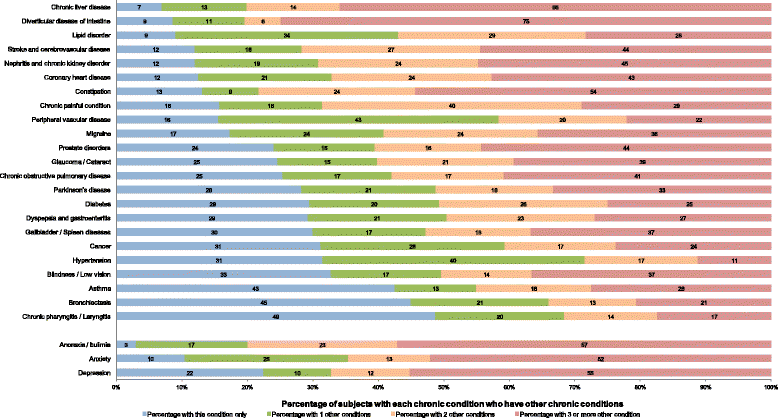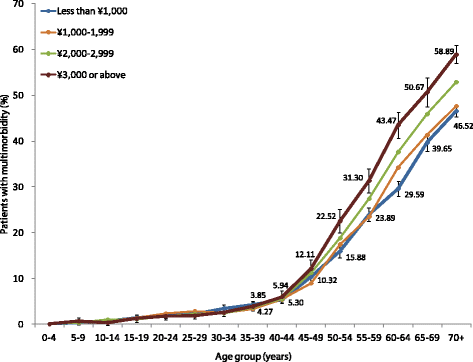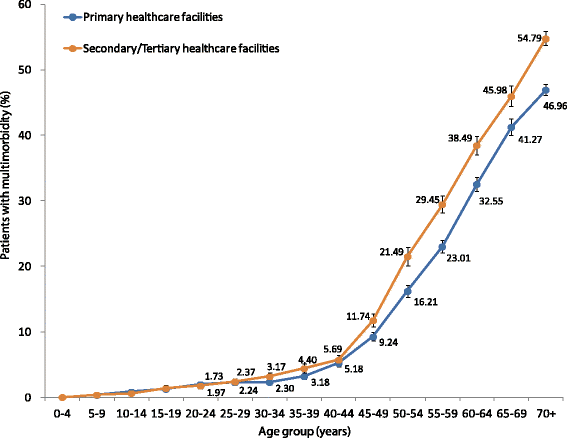Epidemiology of multimorbidity in China and implications for the healthcare system: cross-sectional survey among 162,464 community household residents in southern China
- PMID: 25338506
- PMCID: PMC4212117
- DOI: 10.1186/s12916-014-0188-0
Epidemiology of multimorbidity in China and implications for the healthcare system: cross-sectional survey among 162,464 community household residents in southern China
Abstract
Background: China, like other countries, is facing a growing burden of chronic disease but the prevalence of multimorbidity and implications for the healthcare system have been little researched. We examined the epidemiology of multimorbidity in southern China in a large representative sample. The effects of multimorbidity and other factors on usual source of healthcare were also examined.
Methods: We conducted a large cross-sectional survey among approximately 5% (N = 162,464) of the resident population in three prefectures in Guangdong province, southern China in 2011. A multistage, stratified random sampling was adopted. The study population had many similar characteristics to the national census population. Interviewer-administered questionnaires were used to collect self-report data on demographics, socio-economics, lifestyles, healthcare use, and health characteristics from paper-based medical reports.
Results: More than one in ten of the total study population (11.1%, 95% confidence interval (CI) 10.6 to 11.6) had two or more chronic conditions from a selection of 40 morbidities. The prevalence of multimorbidity increased with age (adjusted odds ratio (aOR) = 1.36, 95% CI 1.35 to 1.38 per five years). Female gender (aOR = 1.70, 95% CI 1.64 to 1.76), low education (aOR = 1.26, 95% CI 1.23 to 1.29), lack of medical insurance (aOR = 1.79, 95% CI 1.71 to 1.89), and unhealthy lifestyle behaviours were independent predictors of multimorbidity. Multimorbidity was associated with the regular use of secondary outpatient care in preference to primary care.
Conclusions: Multimorbidity is now common in China. The reported preferential use of secondary care over primary care by patients with multimorbidity has many major implications. There is an urgent need to further develop a strong and equitable primary care system.
Figures



Similar articles
-
Changes in patterns of multimorbidity and associated with medical costs among Chinese middle-aged and older adults from 2013 to 2023: an analysis of repeated cross-sectional surveys in Xiangyang, China.Front Public Health. 2024 Aug 7;12:1403196. doi: 10.3389/fpubh.2024.1403196. eCollection 2024. Front Public Health. 2024. PMID: 39171301 Free PMC article.
-
Prevalence and patterns of multimorbidity in northeastern China: a cross-sectional study.Public Health. 2015 Nov;129(11):1539-46. doi: 10.1016/j.puhe.2015.06.013. Epub 2015 Jul 22. Public Health. 2015. PMID: 26210070
-
Impacts of multimorbidity on medication treatment, primary healthcare and hospitalization among middle-aged and older adults in China: evidence from a nationwide longitudinal study.BMC Public Health. 2021 Jul 12;21(1):1380. doi: 10.1186/s12889-021-11456-7. BMC Public Health. 2021. PMID: 34253222 Free PMC article.
-
Community prevalence and dyad disease pattern of multimorbidity in China and India: a systematic review.BMJ Glob Health. 2022 Sep;7(9):e008880. doi: 10.1136/bmjgh-2022-008880. BMJ Glob Health. 2022. PMID: 36113890 Free PMC article.
-
[Research progress on multimorbidity of common diseases in children and adolescents].Zhonghua Yu Fang Yi Xue Za Zhi. 2025 Feb 6;59(2):195-201. doi: 10.3760/cma.j.cn112150-20240905-00709. Zhonghua Yu Fang Yi Xue Za Zhi. 2025. PMID: 39748188 Review. Chinese.
Cited by
-
Association between multimorbidity patterns and disability among older people covered by long-term care insurance in Shanghai, China.BMC Public Health. 2021 Feb 27;21(1):418. doi: 10.1186/s12889-021-10463-y. BMC Public Health. 2021. PMID: 33639902 Free PMC article.
-
Global diversity of policy, coverage, and demand of COVID-19 vaccines: a descriptive study.BMC Med. 2022 Apr 4;20(1):130. doi: 10.1186/s12916-022-02333-0. BMC Med. 2022. PMID: 35369871 Free PMC article.
-
The Multimorbidity and Lifestyle Correlates in Chinese Population Residing in Macau: Findings from a Community-Based Needs Assessment Study.Healthcare (Basel). 2023 Jun 30;11(13):1906. doi: 10.3390/healthcare11131906. Healthcare (Basel). 2023. PMID: 37444739 Free PMC article.
-
Impact of Multimorbidity on Symptoms of Depression, Anxiety, and Stress in Older Adults: Is There a Sex Difference?Front Psychol. 2021 Dec 21;12:762310. doi: 10.3389/fpsyg.2021.762310. eCollection 2021. Front Psychol. 2021. PMID: 34992564 Free PMC article.
-
Mapping of global scientific research in comorbidity and multimorbidity: A cross-sectional analysis.PLoS One. 2018 Jan 3;13(1):e0189091. doi: 10.1371/journal.pone.0189091. eCollection 2018. PLoS One. 2018. PMID: 29298301 Free PMC article.
References
-
- World Health Organization: Preventing Chronic Diseases: A Vital Investment. Geneva, Switzerland: 2005.
Publication types
MeSH terms
LinkOut - more resources
Full Text Sources
Other Literature Sources
Medical

